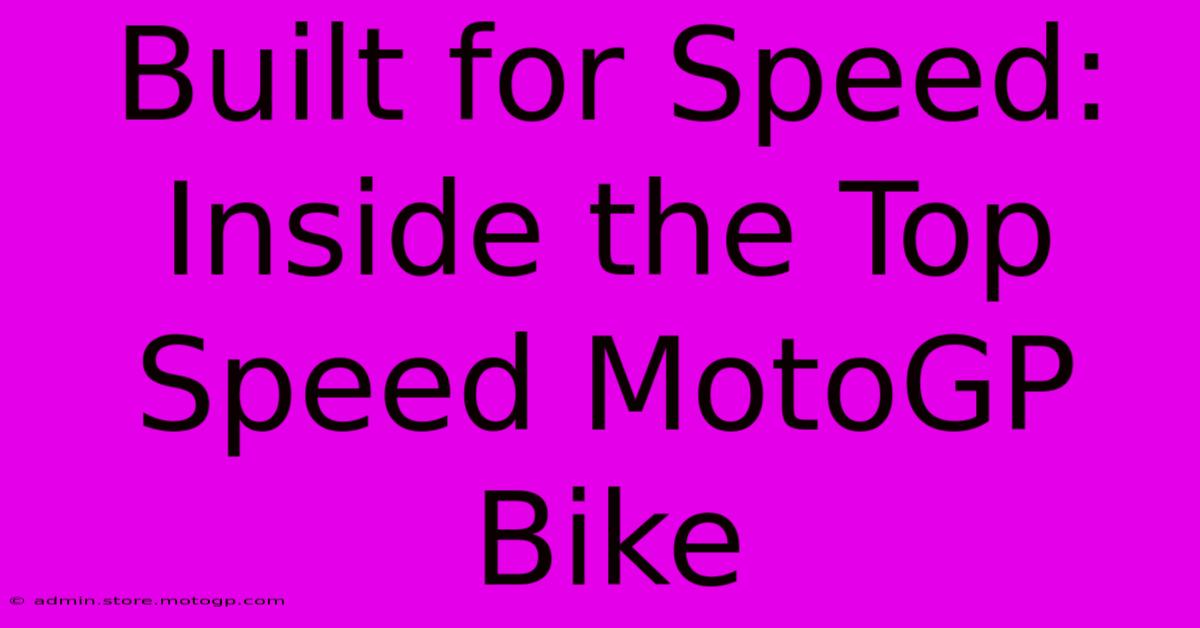Built For Speed: Inside The Top Speed MotoGP Bike

Table of Contents
Built for Speed: Inside the Top Speed MotoGP Bike
MotoGP. The pinnacle of motorcycle racing. The roar of the engines, the breathtaking speeds, the nail-biting finishes – it's a spectacle that captivates millions worldwide. But what makes these machines so incredibly fast? Let's delve into the engineering marvel that is a top-speed MotoGP bike, exploring the key components that contribute to its exhilarating performance.
The Heart of the Beast: The Engine
At the heart of every MotoGP bike lies a screaming, high-revving engine, typically a four-stroke, inline four-cylinder powerplant. These aren't your average street bike engines; they're highly tuned works of art, pushing the boundaries of engineering.
Key Engine Features:
- Extreme RPM: These engines routinely operate at incredibly high RPMs (revolutions per minute), often exceeding 18,000 RPM. This translates to incredibly high power output for their size.
- Lightweight Materials: Titanium, magnesium, and carbon fiber are extensively used to reduce weight, improving the bike's power-to-weight ratio, crucial for acceleration and top speed.
- Sophisticated Electronics: Sophisticated engine management systems, including advanced fuel injection and ignition control, precisely manage fuel delivery and spark timing for optimal performance across the rev range.
- Seamless Gearbox: Seamless shift transmissions allow for incredibly rapid gear changes without any interruption of power, a vital advantage in close racing.
Aerodynamics: Cutting Through the Air
Speed isn't just about horsepower; it's about minimizing resistance. MotoGP bikes employ advanced aerodynamics to slice through the air with minimal drag.
Key Aerodynamic Features:
- Winglets: These small wings, attached to the fairings, generate downforce, improving stability at high speeds and enabling harder braking into corners.
- Streamlined Fairings: The bodywork is meticulously designed to minimize drag, channeling airflow smoothly around the bike and rider.
- Aerodynamic Optimization: Computational Fluid Dynamics (CFD) is extensively used during the design process to fine-tune the aerodynamics for optimal performance. Every curve and angle is carefully considered to minimize drag and maximize downforce.
Chassis and Suspension: Handling the Power
Even with immense power and aerodynamic efficiency, a MotoGP bike needs a sophisticated chassis and suspension system to handle it all.
Key Chassis and Suspension Features:
- Lightweight Frame: Typically constructed from carbon fiber or aluminum, the frame is designed to be incredibly stiff and lightweight, enhancing responsiveness and agility.
- Advanced Suspension: Sophisticated suspension systems, often employing electronics, provide exceptional stability and traction, allowing riders to push the bike to its limits.
- Precise Geometry: The wheelbase, rake, and trail are meticulously designed to provide optimal handling characteristics, allowing riders to navigate corners with precision and speed.
Tires: The Grip Factor
The connection between the bike and the track is absolutely critical. MotoGP bikes rely on specially designed tires to provide maximum grip, even at extreme speeds and lean angles.
Key Tire Features:
- High-Performance Compounds: The tires utilize specialized rubber compounds designed to provide exceptional grip in all conditions, including wet and dry tracks.
- Sophisticated Construction: The tire construction is optimized for high speeds and demanding conditions, providing the necessary stability and feedback to the rider.
- Tire Management: Tire pressure and temperature monitoring are crucial, with riders and teams carefully managing tire conditions to maintain optimal performance throughout the race.
The Rider: The Human Factor
Finally, no discussion of a MotoGP bike's top speed is complete without acknowledging the rider's crucial role. Their skill, fitness, and understanding of the machine are essential in harnessing its full potential. Their ability to manage the bike's power and navigate the track at these immense speeds is a testament to their dedication and talent.
In Conclusion:
The top speed of a MotoGP bike is a testament to years of engineering innovation and relentless pursuit of performance. From the high-revving engine to the sophisticated aerodynamics and the precise handling, every component plays a vital role in achieving these breathtaking speeds. It's a symphony of engineering and human skill, a spectacle of speed and precision that continues to captivate and inspire.

Thank you for visiting our website wich cover about Built For Speed: Inside The Top Speed MotoGP Bike. We hope the information provided has been useful to you. Feel free to contact us if you have any questions or need further assistance. See you next time and dont miss to bookmark.
Featured Posts
-
Moto Gp Images The Perfect Addition To Any Racing Fans Collection
Feb 21, 2025
-
Moto Gp Aero The Battle Against Drag
Feb 21, 2025
-
Moto Gp Vs F1 The Ultimate Test Of Man And Machine
Feb 21, 2025
-
The Most Popular Motorcycle Racing Categories
Feb 21, 2025
-
Tomorrows F1 Grid The Key To Winning The Race
Feb 21, 2025
